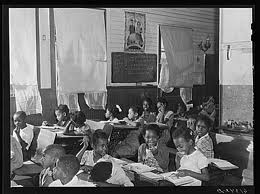The Schooling of a Society

I have written about schools in America's past. It has been shown that achieving an education allows one to be a productive member of society. It is important that everyone get a quality education. In our society we are able to go to school to study and learn life skills. Starting first in the home, young ones learn the social skills necessary to cooperate with the outside world. They are given chores and those chores teach responsibility. As they get older they attend schools. We have many types of schooling available. From the year of 1642 until now, there has been schooling available, whether public or private.This is good because it has been said that many turn to a life of crime because of the lack of education in our modern society. We need to do our society and ourselves a favor and invest in education and take advantage of the opportunity to learn.
Public education became available in the year 1840 with the first common school in America. Before then we had schools only for those who could pay for them. Most education at the time was still limited to certain people. Yet education was not at a total standstill. Those who grew up on farms still had education available to them. As I stated before, chores given at home teach responsibility. Not only that, the chores were a way to teach survival. For those who grew up in rural America lived and worked on farms, this was not an option. There were also apprenticeships where a young man was trained by a business owner in the community where they both resided. After the invention of common schools for formal public education came the normal schools that offered more specialized education and higher pay to teachers that taught there. Today there is more in the way of educational opportunities.
In our society there are more ways to become educated that there were before. The population has become more diversified. New discoveries are made about what can be learned and how to learn. Also the talents and skills of individuals are considered.
The first diversified school was the one in the New Netherland colony in the year of 1664. This school was set up during colonial era. This was a non English school located on the eastern seaboard of North America.
During the common school era, there was a focus on molding a more perfect society. Young women and men were allowed to attend these schools. The schools were the one room schoolhouse type. The attendees were taught reading, writing and arithmetic by one teacher. The schools were publicly supported but the student's parents paid a certain amount for their children to attend these schools.
The grammar schools of that time were schools that centered on the teaching of languages such as Latin. The sons of the business leaders attended these. Such leaders were planters, shipping magnets, etc. Their children were also sent abroad to boarding schools. Most of these schools were in England.
Formal training included for:
- Men - Greek, Latin, science, mathematics, navigation, geography, history, social ettiquette and plantation management. And of course, reading and writing.
- Women - Sewing, cooking, ettiquette, music classes as well as reading and writing. Even lessons on guiding the home.
The very poor learned what their parents taught them at home mostly with very little formal schooling involved.
Later schools that involved formal training were Indian Mission schools for Native Americans and Freedmen schools for African Americans.
Native American schools were set aside to assimilate Native Americans into the European culture. Teaching the natives the English language was not a bad thing. It was unnecessary, however, to try to make these people over as Europeans. Lesson learned: Don't try to change a people group into another people.
The Freedman Bureau created by the Freedman's Bureau bill of 1865 was initiated by Abraham Lincoln. The intent of the bureau was for the establishing of an employer- employee relationship with freed slaves and their formal masters. The plan did not go well in the beginning and continued to fail. The bureau was operational from 1865 to 1872. It was disbanded by Ulysses S. Grant.
By 1866 the American Missionary Association in conjunction with the federal bureau established 11 colleges in southern to aid in education the formal slaves who wanted to establish schools in order to teach their children. Funds raised were for paying teachers and attending to the operation of the schools.
Booker T. Washington and Brigadier General Samuel Chapman Armstrong, founder of the Hampton Institute began to call out for institutions of higher learning for the freed people. Twenty five colleges were established for these young people by the American Missionary Association and the Freedman Bureau. Many of these schools still exist today.
Lesson learned: You can't force people to get along and live in peace. You can establish institutions of learning and without standing in the way of the ones who want to learn, they will be successful.
- Applied Research Center - Historical Timeline of Public Education in the US
The Applied Research Center (ARC) is a 30-year-old racial justice think tank that uses media, research and activism to promote solutions. ARC’s mission is to popularize racial justice and prepare people to achieve it. ARC also serves as the publisher - Common School Movement - Colonial and Republican Schooling, Changes in the Antebellum Era, The Rise
Today's Schools
Early childhood education offers socialization skills. The students learn how to cooperate with each other. Emphasis is based on reading readiness and other skills that prepare them for kindergarten and grammar or elementary school. Children are taught the basics to help them succeed in future schooling. There are state lottery funded pre k programs to teach reading readiness. It is best, however, for parents to teach their children what they want them to know. Also for parents to be involved in knowing what their child is learning.

Grammar, Middle and High school
The basic one room school house has come and gone. Today there are still grammar schools, but they consist of Kindergarten to 5th grade. Middle schools are for grades 6 to 8. High schools are grades 2 through 12. The goal and this level is to build on the skills for the future careers of students or College life.
- Grammar or Elementary - Kindergarten to Grade 5.
- Middle School - Grades 6 to 8.
- High School - Grades 9 to 12.
Charter Schools
This definition of a charter school is taken from the N.E.A (National Education Association) website: Charter schools are publicly funded elementary or secondary schools that have been freed from some of the rules, regulations, and statutes that apply to other public schools, in exchange for some type of accountability for producing certain results, which are set forth in each charter school's charter.
This type of school is supposed to produce a certain quality student in order to remain open and in good standing. It's curriculum should be different from that offered in established public schools. Supposedly more results oriented than a traditional public school. A charter school must maintain a higher level of excellence.
Magnet Schools
There are schools that have developed programs that place special emphasis on the specific skills students have. Other students with similar skills from other public schools from another zone within the same county may attend. Hence the name Magnet School. There are magnet schools at the elementary, middle and high school levels.
Ombudsman Programs
There have always been the exceptions to the rule or special circumstances in the lives of individuals that would prevent them continuing their education. This is no excuse to leave out anyone with a special circumstance that may keep them from achieving their full potential.

Private schools
Private or non state funded schools are independent from the states regulations. Students are selected for this type of school. Those selected may be eligible to attend this type of school at a lower cost through a scholarship based on his or her talent. These schools may or may not be religious in nature. To be a private school, it is privately owned. Parochial or Catholic schools as well as schools that focus on other religious denominations are represented in the private school sector. These schools comply with the basic curricula that are available to public schools, but have religious or other specialized instruction.
Many of these tools from the past have been put into place to provide quality education for us. This is to make our society better as we strive to achieve more by the way of education. No one should be left out. Many ways have been made to increase funding and provide new opportunities from the 1850's until now. There should be no excuse for not pursuing and getting an education today.
Early childhood education in Day care and Kindergarten
- Education.com | An Education & Child Development Site for Parents | Parenting & Educational
Education.com provides activities, worksheets, videos, expert advice and a school directory to give parents information and ideas to help kids reach their full potential and make learning fun. - 10 Kindergarten Readiness Skills Your Child Needs | Education.com
What do teachers really want your child to know on the first day of kindergarten? The top 10 kindergarten readiness skills your child needs, and how to help.
- History of education in the United States - Wikipedia, the free encyclopedia
Education for women and girls. - Cultural assimilation of Native Americans - Wikipedia, the free encyclopedia
Education of Native Americans - Hampton University - Wikipedia, the free encyclopedia
- Howard University
Howard University is a comprehensive research university, unique and irreplaceable, defined by its core values, the excellence of all its activities in instruction, research and service, and by its enduring commitment to educating youth, African Amer
- Charter school - Wikipedia, the free encyclopedia
A private public school. - Valdosta Schools partner with Ombudsman | WALB-TV Channel 10 News | Valdosta, Ga. - YouTube
A new education program is underway in Valdosta to help at-risk students get on the right track. The school system is partnering with a private company calle... - HowStuffWorks "Public Schools"
Public schools educate about 50 million students a year. A look at costs, challenges, magnet and charter schools and teacher quality.
Non Traditional Learning
- Magic Johnson Bridgescape Academies to Help Ohio Dropouts Earn Their High School Diploma | EdisonLea
Another way to help students achieve. Get your diploma not a GED.






